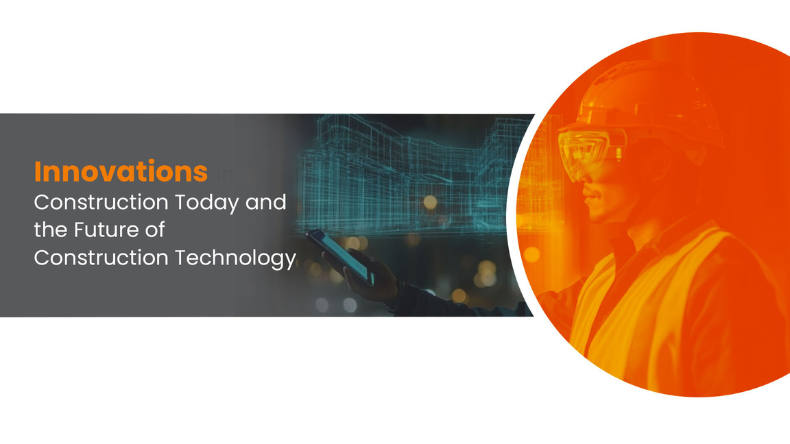Reading Time: 11 minutes
Abstract
The construction industry has long been characterized by its slow adoption of technology compared to other industries. However, recent advances in digital tools, robotics, sustainable materials, and project management techniques are transforming construction processes and enhancing project outcomes. This paper explores present-day innovations driving the construction sector and forecasts potential future advancements. By understanding the latest technologies and emerging trends, stakeholders can better anticipate how to improve efficiency, sustainability, and profitability in construction.
Introduction
Construction innovation is fundamentally reshaping how buildings and infrastructure are designed, built, and managed. Traditional processes are being augmented and sometimes replaced by digital and automated tools that enhance precision, reduce project duration, improve safety, and address the critical need for sustainable development. With population growth and urbanization driving a surge in construction demand, the adoption of new technologies has become essential. This paper provides an in-depth analysis of the present-day innovations revolutionizing construction and the promising technologies on the horizon.
Current Innovations in Construction
1. Building Information Modeling (BIM)
Overview: Building Information Modeling (BIM) is a digital representation of the physical and functional characteristics of a structure. It allows all stakeholders, including architects, engineers, contractors, and owners, to collaborate on a unified platform.
Work Smarter, Not Harder
iFieldSmart empowers your team with AI-driven efficiency to simplify scheduling, boost collaboration, and keep projects on track.
Schedule a MeetingApplications:
– Enhanced Collaboration: BIM enables a collaborative approach, allowing real-time data sharing and modification.
– Cost and Time Efficiency: By identifying potential issues in the design phase, BIM reduces project delays and cost overruns.
– Lifecycle Management: BIM extends beyond construction, offering utility throughout the lifecycle of a building for maintenance and operation.
Current Trends:
– 5D and 6D BIM: New dimensions of BIM integrate cost and sustainability data, allowing for financial and environmental analysis.
– BIM and IoT Integration: Sensor data from buildings can be integrated into BIM models to monitor real-time performance.
2. 3D Printing
Overview: 3D printing, also known as additive manufacturing, is gaining traction as a way to quickly produce complex components and even entire structures. By using various materials like concrete, plastic, and metal, 3D printing provides flexibility in design and material use.
Applications:
– On-Site and Off-Site Printing: 3D printers can be mobilized on-site or used in a factory setting to produce building components.
– Cost Reduction: By reducing material waste and labor costs, 3D printing can lower overall project expenses.
– Speed: 3D printing shortens construction time, particularly beneficial in housing projects and emergency infrastructure.
Current Trends:
– Large-Scale Printing: The use of larger printers allows for the construction of entire homes and buildings.
– Sustainable Materials: Researchers are exploring the use of recycled materials in 3D printing, making it more eco-friendly.
3. Robotics and Automation
Overview: Robotics are transforming construction sites, from bricklaying robots to autonomous equipment that can operate without human intervention.
Applications:
– Bricklaying and Concrete Pouring Robots: These robots automate repetitive tasks, increasing productivity and reducing labor costs.
– Drones: Drones assist with surveying, mapping, and monitoring, providing real-time site data without the need for manual inspections.
– Autonomous Vehicles: Self-driving trucks and excavators reduce the risk of accidents and improve site efficiency.
Current Trends:
– AI-Enhanced Robotics: AI algorithms enable robots to make decisions and adapt to site conditions.
– Increased Safety: Robots can perform hazardous tasks, reducing the risk of injury to human workers.
4. Prefabrication and Modular Construction
Overview: Prefabrication and modular construction involve assembling building components off-site and then transporting them to the site for final assembly. This method can lead to faster project timelines, reduced waste, and increased quality control.
Applications:
– Reduced Construction Time: Components are fabricated in a controlled environment, reducing weather-related delays.
– Sustainability: Modular construction produces less waste and consumes fewer resources.
– Quality Assurance: Standardized production methods improve consistency and quality.
Current Trends:
– Mass Timber Construction: Timber is being used in modular buildings for its sustainability and aesthetic appeal.
– Urbanization Solutions: Modular construction is gaining traction as a solution for rapid urban development, particularly in residential housing.
5. Green Building Materials
Overview: The shift toward sustainable materials is transforming the way buildings are constructed, with an emphasis on reducing carbon footprint and enhancing energy efficiency.
Applications:
– Recycled Materials: Using recycled concrete, plastic, and glass can lower construction costs and environmental impact.
– Energy-Efficient Insulation: New materials, such as aerogels and phase-change materials, improve insulation and reduce energy consumption.
– Green Concrete: Developed to reduce the carbon footprint, green concrete incorporates industrial waste materials like fly ash.
Current Trends:
– Carbon-Capture Concrete: This technology absorbs CO₂ over its lifetime, making it an ideal solution for reducing emissions.
– Bio-Based Materials: Materials like bamboo and mycelium offer sustainable alternatives that can be used in modular and prefabricated construction.
Future of Construction Innovation
The future of construction innovation will be shaped by continued advancements in automation, AI, sustainable materials, and smart infrastructure. The following emerging technologies and trends are expected to revolutionize construction in the coming years.
1. Artificial Intelligence (AI) and Machine Learning
AI has the potential to optimize every aspect of construction, from planning to project completion. Machine learning algorithms can process vast amounts of data, improving project efficiency, safety, and sustainability.
Predicted Applications:
– Predictive Analytics: AI can analyze historical project data to predict risks and recommend preventive measures.
– Automated Design: AI-driven software can generate optimized designs based on input criteria, reducing the time spent in the design phase.
– Enhanced Decision-Making: Machine learning can offer insights to improve resource allocation, budgeting, and scheduling.
2. Digital Twin Technology
A digital twin is a virtual replica of a physical asset, created to optimize asset performance. By integrating real-time data from sensors, digital twins enable more effective monitoring and management of construction projects.
Predicted Applications:
– Real-Time Monitoring: Digital twins provide a dynamic, real-time view of project progress, allowing stakeholders to address issues promptly.
– Lifecycle Management: Post-construction, digital twins continue to deliver value by offering insights into maintenance and energy consumption.
– Predictive Maintenance: Digital twins can anticipate and alert stakeholders to potential failures, reducing downtime.
3. Advanced Robotics and Autonomous Construction Sites
Future construction sites will likely see widespread use of robotics, from autonomous earth-moving equipment to robotic bricklayers and 3D printing robots.
Predicted Applications:
– Fully Autonomous Sites: Robots will perform most on-site tasks, minimizing human intervention.
– Multi-Function Robots: Robots capable of adapting to various tasks will enhance flexibility and productivity.
– Human-Robot Collaboration: Exoskeletons and AI-powered tools will augment human capabilities, enabling workers to perform tasks with greater precision and less fatigue.
4. Augmented Reality (AR) and Virtual Reality (VR)
AR and VR are poised to revolutionize construction design, training, and project management by providing immersive, interactive experiences.
Predicted Applications:
– On-Site Visualization: AR will allow project managers and stakeholders to overlay virtual models onto physical spaces, facilitating design adjustments.
– Training: VR provides a safe and immersive way to train workers on equipment operation and safety procedures.
– Remote Collaboration: AR and VR enable remote stakeholders to participate in site inspections and meetings as if they were on-site.
5. Sustainable and Self-Healing Materials
Future materials will focus on enhancing durability, reducing environmental impact, and, in some cases, maintaining themselves.
Predicted Applications:
– Self-Healing Concrete: Concrete infused with bacteria or polymers that can repair cracks autonomously, extending the lifespan of structures.
– Photovoltaic Glass: Glass embedded with solar cells to generate electricity, making buildings more energy-efficient.
– Recyclable Building Components: Materials designed to be easily dismantled and reused or recycled, aligning with the principles of circular construction.
6. Blockchain for Transparent Project Management
Blockchain, known for its secure, immutable nature, could play a significant role in streamlining construction project management and procurement processes.
Predicted Applications:
– Smart Contracts: Blockchain-based contracts can automate payments and document management, reducing the risk of disputes.
– Supply Chain Transparency: Blockchain enables end-to-end tracking of materials, improving accountability and reducing the risk of fraud.
– Data Security: Storing project information on blockchain enhances data security and ensures a transparent, auditable record of decisions and modifications.
Construction Management Software and 360 Photo Documentation Software
In the modern construction industry, digital tools are essential for managing complex projects. Among these tools, construction management software and 360-degree photo documentation software are instrumental in improving efficiency, transparency, and project oversight. This article provides an overview of these two types of software, their features, benefits, and how they contribute to successful project delivery.
Construction Management Software
Construction management software (CMS) is a digital platform that integrates various aspects of a construction project, including scheduling, budgeting, communication, document management, and task tracking. It allows project managers and stakeholders to coordinate work in real-time, maintain accurate records, and make informed decisions. CMS has become a critical tool for construction firms looking to streamline operations, reduce costs, and improve project outcomes.
Key Features:
- Project Scheduling and Planning: CMS typically includes Gantt charts, task lists, and milestone tracking to help managers keep projects on schedule. Advanced CMS platforms can even include AI-driven predictive scheduling, which analyzes historical data to forecast delays and optimize timelines.
- Budget and Cost Control: CMS tracks expenses, labor costs, and resource allocation to ensure that projects stay within budget. Real-time financial reporting allows for better forecasting and cost management.
- Document Management: With CMS, all project-related documents, such as blueprints, contracts, and compliance records, are stored in a centralized database. This makes it easier for team members to access up-to-date information.
- Collaboration Tools: CMS enables streamlined communication and collaboration among team members, stakeholders, and subcontractors. Many platforms offer integrated messaging, notifications, and even video conferencing capabilities.
- Risk and Compliance Management: CMS can identify risks related to safety, scheduling, or cost overruns, enabling proactive mitigation strategies. Some systems integrate with compliance standards, ensuring projects meet regulatory requirements.
Benefits:
By consolidating project management into one platform, CMS reduces errors, improves communication, and minimizes inefficiencies. The transparency it offers is invaluable for both internal and external stakeholders, promoting accountability and trust.
360 Photo Documentation Software
360-degree photo documentation software provides a visual record of construction progress through interactive, panoramic photos taken at regular intervals on-site. Using specialized cameras and software, construction teams can capture detailed, navigable images of the site, documenting each phase from multiple angles. This technology is highly useful for progress tracking, quality control, and issue resolution.
Key Features:
- 360-Degree Imaging: Using 360-degree cameras, this software captures comprehensive, immersive images of the construction site, allowing users to explore the area as if they were physically present.
- Progress Tracking: By scheduling regular photo captures, project managers can create a time-lapse of the project’s progress. This visual documentation enables easy comparison between planned and actual progress, helping to identify delays or deviations.
- Integration with BIM and CMS: Some 360 photo documentation tools can integrate with BIM models and CMS, providing a visual layer that adds context to project data. This integration enhances decision-making by allowing users to verify site conditions against digital models.
- Remote Accessibility: Stakeholders who cannot visit the site regularly can access the 360-degree photos from anywhere, allowing for remote inspections and collaboration.
Benefits:
The primary advantage of 360 photo documentation is its ability to reduce the need for physical site visits, saving time and resources. The software also supports dispute resolution by providing an objective visual record, which can clarify misunderstandings about site conditions and construction phases.
Both construction management software and 360 photo documentation software have become indispensable in modern construction projects. While CMS streamlines project operations, enhances communication, and controls costs, 360 photo documentation offers real-time visual insights, ensuring transparency and accountability.
Together, they enable a more efficient, data-driven approach to construction, contributing to successful project outcomes and greater client satisfaction. As technology advances, these tools will likely continue to evolve, offering even more powerful capabilities to meet the demands of an increasingly complex construction landscape.
Conclusion
The construction industry is at a pivotal point, with innovations reshaping every facet of building design, planning, and execution. Today’s construction projects benefit from advancements in BIM, robotics, 3D printing, and sustainable materials, leading to more efficient, cost-effective, and eco-friendly construction. Looking ahead, AI, digital twins, augmented reality, and self-healing materials will further revolutionize construction, driving the industry toward fully autonomous, sustainable, and intelligent infrastructure development.
The future of construction holds promise for significant advancements in technology, which will enhance collaboration, efficiency, safety, and environmental stewardship. Embracing these innovations will be critical for stakeholders aiming to meet the growing demands for urbanization, environmental sustainability, and efficient resource management. The companies that lead in adopting these technologies will gain a competitive edge, positioning themselves as pioneers in a rapidly evolving industry.








